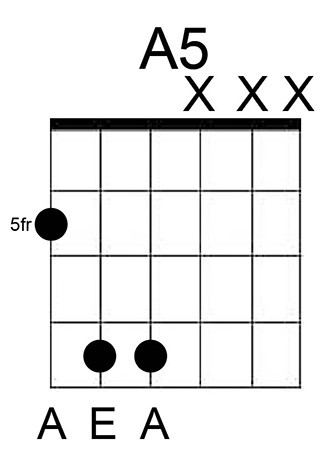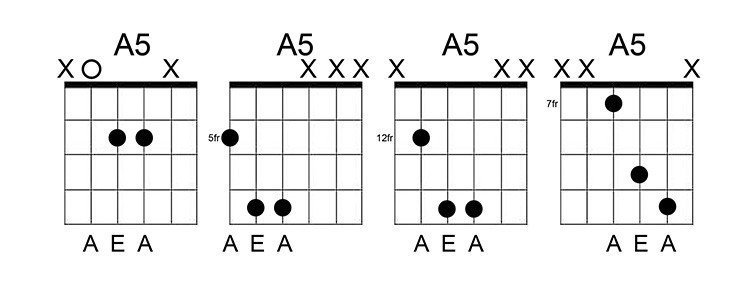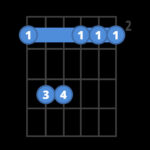The A5 chord is a foundational and powerful chord that every guitarist should know. Its versatility spans across genres, making it an indispensable tool in your guitar playing arsenal. In this guide, we’ll explore various ways to play the A5 chord, uncover its construction, and provide tips to make it sound incredible.
Master the A5 Chord: Easy Versions for Beginners
The A5 chord is celebrated for its simplicity and impact. It’s often one of the first power chords beginners learn due to its straightforward fingering and strong sound. Let’s look at the most common beginner-friendly version of the A5 chord:
(If the image below is confusing, check out our guide on “How To Read Guitar Chordboxes In 60 Seconds” for a quick understanding!)
 easy-chords
easy-chords
Alt text: Beginner-friendly A5 chord diagram showing index finger on the second fret of the D string and middle finger on the second fret of the G string.
You can play this A5 chord in two primary ways:
- Two-Finger Method: Place your index finger on the 2nd fret of the D string and your middle finger on the 2nd fret of the G string.
- Barre Method: Barre your index finger across both the D and G strings at the 2nd fret.
For both methods, strum from the open A string down to the G string.
Technique Tip: Focus on strumming only the A, D, and G strings, avoiding the B and high E strings for a cleaner A5 sound.
While the two-finger method might be easier initially, practicing the barre version will enhance your finger strength and dexterity. Remember, the most important thing is hitting the correct notes to create the A5 chord, regardless of the technique you use.
Understanding the A5 Chord: Building Blocks
What exactly makes up an A5 chord? It’s surprisingly simple: just two notes – A and E.
- In music theory, these notes represent the root (1st) and the perfect fifth (5th) intervals of the A major scale (and many other scales in A).
- Each note in a scale has a degree or value. The root (1st) and the perfect fifth (5th) are fundamental and rarely change across different scales, making the A5 chord a stable and versatile building block in music.
This simplicity makes the A5 chord, and other “5th” chords, excellent starting points for guitarists. Unlike major and minor chords, the A5 chord is neither major nor minor, giving it a unique sonic character.
A5 Chord vs. Major and Minor: The Sonic Difference
The A5 chord, containing only two notes, lacks the third interval that defines major and minor chords.
Major and minor chords have three notes, while the A5 chord has only two – the root and the fifth.
This absence of the third gives the A5 chord a more ambiguous, often described as “darker” or more “open,” sound compared to A major or A minor. This sonic neutrality allows it to fit into a wider variety of musical contexts.
Think of “5th chords” or power chords as stripped-down, raw versions of major and minor chords.
Ear Training Exercise: Play an A Major chord, then an A Minor chord, and finally the A5 chord. Concentrate and listen carefully to the tonal differences between them.
- Notice how the major chord sounds bright and happy, the minor chord sounds sad or melancholic, and the A5 chord sounds powerful yet neutral.
- Developing this skill of discerning chord qualities by ear is crucial for musical growth. It requires focused listening and intentional practice, not just passive exposure.
Close your eyes and repeat this exercise – you’ll be surprised at how quickly your ear can learn to differentiate these core chord types.
 a5-chord
a5-chord
Alt text: Image contrasting the visual representation of A Major, A Minor, and A5 chords on guitar fretboard diagrams.
Unleash the Power: The A5 Power Chord for Intermediate Players
“5th chords” are widely known as “power chords,” especially in rock and heavier genres. Let’s explore the quintessential A5 power chord.
Practice transitioning between the A5 and E5 power chords as shown below:
Technique Tip: Experiment with different strumming patterns for these power chords. Try both up and down strums, as well as only downstrokes. The key is to isolate your strumming to the intended strings, avoiding unwanted string noise.
 easy-guitar-chord-for-a5
easy-guitar-chord-for-a5
Alt text: Diagram showing the A5 power chord and E5 power chord shapes for practicing chord changes.
Power Chords and Fifths: Understanding the Terminology
Let’s clarify the terminology around “5th chords” and “power chords” as it can be a source of confusion.
Technically, any chord built with a root and a fifth, like A5, is a “power chord,” regardless of how it’s played.
However, in guitar vernacular, “power chord” often specifically refers to the three-string version commonly used in rock music.
Pro Tip: Guitarists frequently use the terms “power chords” and “fifths” interchangeably because these chords are named “Something 5,” such as A5, D5, and E5.
Power chords are favored in rock and related genres for their strong, “beefy” sound, but their versatility extends beyond rock. They are effective in funk, pop, blues, and many other styles.
Here’s the most common A5 power chord shape, played at the 5th fret on the low E string:
 A5-Chord
A5-Chord
Alt text: A5 power chord diagram at the 5th fret on the low E string, commonly used in rock music.
Experiment with Sound: Grab your guitar pick, turn up your amplifier (if you have one), add some gain or overdrive, and strum this A5 power chord with authority (be mindful of your string gauge!).
Feel the power and resonance?
Now, try picking each of the three strings individually, letting them ring out together.
This technique is called an arpeggio, and it highlights the individual notes within the chord.
Listen to the difference. The A5 chord can be heavy and driving, or light and melodic. Its versatility is in your hands!
To further explore arpeggios, check out our dedicated lesson on guitar arpeggios.
Let’s explore more positions for playing the A5 chord.
 A5-chord
A5-chord
Alt text: Visual representation of different A5 chord positions on the guitar fretboard demonstrating chord versatility.
Three Additional A5 Chord Positions to Explore
As mentioned, the A5 chord is easily adaptable to different positions across the fretboard.
Learning various chord positions enhances your fretboard awareness and expands your chord vocabulary.
Another A5 position is found at the 12th and 14th frets:
This higher position gives the A5 chord a brighter, higher-pitched quality compared to the lower fret versions.
- While suitable for rock, this higher A5 voicing shines on acoustic guitar or with a clean electric guitar tone, enhanced by reverb and delay effects.
Challenge Yourself: Experiment with each A5 variation and listen to the subtle (or not so subtle) differences in tone. After practicing A5, try applying the same shapes to create a G5 chord! (For example, the same shape at the 10th fret on the A string would create a G5).
 a5-chord
a5-chord
Alt text: Diagram showing a higher-register A5 chord position and its bright sonic characteristics.
While these positions are all A5 chords, their string placement influences their sound. Learning different variations is beneficial, but focusing on a few core shapes is perfectly fine, especially when starting.
Remember, the “5th” chord shape is moveable! You can slide the same hand shape up and down the neck to create different power chords.
You can also add your pinky finger to the top note to create a fuller chord voicing (adding another A note), though it’s not essential for the core A5 sound.
We’ve also included a bonus A5 version on the D string at the 7th fret. The same technique applies – just shift your pinky finger up one fret if you want the fuller voicing!
 A5-chord-chart
A5-chord-chart
Alt text: Comprehensive A5 chord chart showcasing multiple positions and variations across the guitar fretboard.
The Power of Simplicity: Why the A5 Chord Works
The A5 chord’s effectiveness lies in its simplicity and sonic impact.
- Its stripped-down nature, with just two notes, makes it both easy to play and highly versatile in musical applications.
- The minimal structure allows it to be powerful and aggressive in genres like punk rock with heavy distortion.
- Conversely, its open sound creates space and clarity, making it ideal for gentler musical styles and allowing vocalists to sit comfortably within the mix.
Skill Tip: The A5 chord is perfect for beginner guitarists to practice finger pressure and fretting technique. It provides a full sound without requiring complex finger stretches.
It’s also a valuable tool for experienced guitarists seeking a less cluttered, more impactful chord voicing. The A5 chord is a testament to the idea that sometimes, less is indeed more in music.

